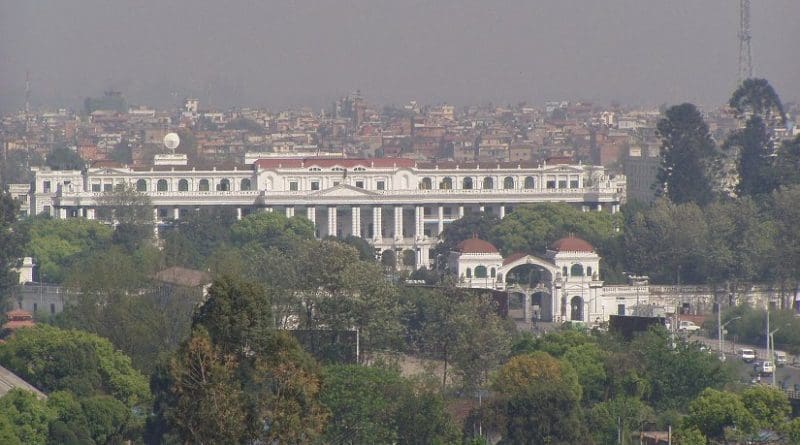Delaying Constitution Amendment Process In Nepal: Who Benefits? – Analysis
By S. Binodkumar Singh*
It has been almost nine years since the Constitution drafting process started in Nepal with the election of the first Constituent Assembly (CA) in May 2008, following a 10-year-long insurgency by the Maoists that ended with the Comprehensive Peace Agreement (CPA) of 2006.
Consensus eluded the first CA, constituted on May 28, 2008, with mandate to deliver the Constitution by May 28, 2010, and finally it was dissolved on May 27, 2012, after four extensions.
Subsequently, in a historical step forward, Nepal’s second CA — constituted on January 21, 2014 — adopted a new Constitution with 308 articles, 35 parts and nine schedules on September 20, 2015.
While the adoption of the new Constitution was welcomed by most national and international groups, a large segment of the population, particularly the Madhesis and Tharus — residing in the southern Terai region of the country and considered as marginalised groups — contested the new Constitution.
The Madhesis subsequently blockaded border points with India from September 23, 2015 leading to acute scarcity of essentials in the land-locked Himalayan nation. The protestors finally ended their agitation on February 5, 2016, after 135 days. More than 50 people were killed in protest-related violence.
In an effort to end the political logjam, the Communist Party of Nepal-Maoist Centre (CPN-Maoist Centre)-led government, on November 29, 2016, got registered a seven-point Constitution Amendment Bill as the Madhesi parties had served an ultimatum — which ended on November 28, 2016 — to bring forth an amendment proposal.
However, the government’s move came amidst strong objections from the main opposition party, the Communist Party of Nepal-Unified Marxists-Leninists (CPN-UML). In particular, the party objected to the proposal to change boundaries of Province No.4 and Province No.5. Significantly, on December 1, 2016, CPN-UML started obstructing parliamentary proceedings, terming the Constitution Amendment Bill as anti-national.
Since then, nine opposition parties, including the CPN-UML, have been obstructing the House business asking that the local-level elections be held before the Constitution amendment process.
As a result, to appease the opposition parties — and amid opposition from the agitating Madhes-based political parties, a Cabinet meeting held at the Prime Minister’s official residence at Baluwatar in Kathmandu on February 20, 2017, decided to hold the local-level polls across the country in a single phase on May 14, 2017, after a gap of 20 years. The last local elections were held in Nepal in May 1997.
Remarkably, nearly three months after the registration of the Constitution Amendment Bill, with the opposition parties softening their stance and allowing deliberations on it, the Parliament on February 23, 2017, finally began general discussions on the Constitution Amendment Bill. Concluding the discussions on the Bill, the House decided to provide lawmakers 72 hours to register any further Amendments. Lawmakers can register written amendment proposals within the given time-frame.
But, already, the opposition parties have claimed that they will not allow the Constitution Amendment Bill to be endorsed by the House. On February 26, 2017, CPN-UML Chairman K.P. Sharma Oli reiterated that his party would not allow the House to pass the Bill under any circumstances as the Bill tabled in the Parliament was not in the interest of the nation.
Separately, on February 26, 2017, the Rastriya Prajatantra Party (RPP), a member of the ruling coalition with two Ministers in the Cabinet, urged the government and all the political parties to put on hold the Constitution Amendment Bill in Parliament. The party demanded that the government create an environment of consensus before beginning discussions on the Bill, claiming that moving forward the Bill in the current situation would produce undesirable impacts and spoil the environment for local-level elections slated for May 14.
Disturbingly, the Federal Alliance, a coalition of 28 regional-based parties that are demanding identity-based autonomous states in Nepal and equal representation in Parliament, at a meeting of the alliance held in Kathmandu on February 24, 2017, decided to launch a movement against the government’s decision to hold local-level polls on May 14.
Separately, on February 25, 2017, Manish Kumar Suman, General Secretary of the Sadbhawana Party, a key constituent of the United Democratic Madhesi Front (UDMF), warned that the UDMF would withdraw the support given to the government within the next 24 to 48 hours. UDMF consists of four Madhesi parties — Federal Socialist Forum Nepal (FSFN), Sadbhawana Party, Terai Madhes Democratic Party (TMDP) and Terai Madhes Sadbhawana Party (TMSP).
The Federal Alliance and UDMF had supported the formation of a new government under Communist Party of Nepal-Maoist Centre (CPN-Maoist Centre) Chairman Pushpa Kamal Dahal after signing a three-point agreement with the CPN-Maoist Centre and Nepali Congress (NC) in August 2016.
Since the restoration of parliamentary democracy in 1990, unstable politics, frequent ruptures of political parties and all-too-frequent changes of government have plagued Nepal. The country has seen 24 government changes in the last 27 years.
Dahal’s return is unlikely to end the revolving-door politics that has sapped business confidence in one of the world’s poorest countries. The Maoists are the third biggest group in the legislature. However, the Constitution Amendment Bill requires at least a two-thirds majority vote in Parliament for endorsement.
As the main opposition party the CPN-UML has objected to the amendment and the agitating UDMF and Federal Alliance remain non-committal towards it, it is uncertain whether the Bill will secure passage through Parliament.
It is high time the major parties come together to address the concerns of the agitating parties and fostered an environment conducive to the local-level polls. The best way forward is to go for elections as this gives political parties an opportunity to establish their agenda and bring about amendment accordingly after the elections.
*The author is Research Associate at the Institute for Conflict Management, New Delhi. Comments and suggestions on this article can be sent to [email protected]

